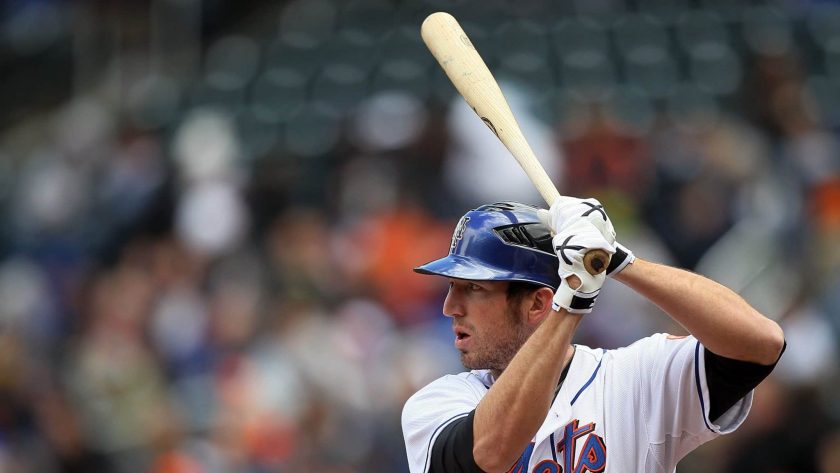Remember the New York Met: Future superstar Ike Davis

ESNY travels back in time to a season where it looked like Ike Davis was going to be a star for the New York Mets.
At a school that was mostly Jewish, like mine, seventh grade, which started in September 2009, was Bar Mitzvah season. And Bar Mitzvah season meant I quickly discovered how much I hated Bar Mitzvahs.
They were all the same. You stood in a dark room as people danced around you. If you could, you stayed off to the side, because you couldn’t dance. You didn’t know how to talk to girls either, so you did your best to be unobtrusive, almost invisible. Eventually, mercifully, you would get to leave. The one saving grace was that sometimes, you could sneak outside for a minute and turn on the radio you kept in your pocket, and check the score of the New York Mets game.
No, I didn’t know how to talk to girls in seventh grade. But I did develop a crush on a school friend, a harmless seventh-grade pang that never came to anything. We talked: we gossiped about classes and teachers and classmates and the like. But those aren’t the conversations I most remember.
I most remember the conversations we had about Ike Davis.
Ike was the hot new thing in the spring of 2010, just when Bar Mitzvah season was at its peak. The Mets had called him up a few weeks into the 2010 season to play first base after they cut Mike Jacobs. I don’t remember how he became a topic of conversation for us, and then an inside joke. But somehow or other, he did.
Ike was young, cute, and Jewish—and he batted .324/.415/.500 in his first 11 games. Almost instantly, he was a New York icon. Signs and t-shirts displayed “I Like Ike,” which had been out of fashion in Queens since the borough had voted for Eisenhower in 1956. Three times in his first two weeks, he made the same spectacular catch, flipping into the first-base dugout and holding the ball as he anchored himself on the dugout wall with his left arm. He was going to be a star. It was obvious.
Ike was making fans smile, and so was the rest of the team. The Mets started strong and kept it up longer than anyone expected. They went as high as 11 games above .500 in the first half, and were 48-40 at the All-Star break. They were only four games out of first place in the division. Ángel Pagán was a star. David Wright was back at the top of his game. Johan Santana was dominant. Mike Pelfrey looked like an ace. Francisco Rodriguez was nailing down every save. And Ike, of course, was going to win Rookie of the Year.
92 losses in 2009 really had been a mirage. We were back to our winning ways. With this roster, what could go wrong?
The second half was a cruel education.
Wright faltered. Pagán slipped. Santana got hurt. Pelfrey was okay but not great. Jason Bay had already been disappointing, but in July he crashed into the wall at Dodger Stadium and missed the rest of the season with a concussion. And in the second half, even Ike didn’t look that good.
The second half of the 2010 season taught a cruel lesson that most Mets fans had probably already learned, but that all have to learn eventually: don’t buy the hype. Don’t believe the breathless anticipation. Don’t buy into a 10-game sample, or even half a season’s worth of stats. Wait until it’s real.
Ten years later, of course, we know the real story of the 2010 season: it was a transition point. The next Mets team was starting to take shape, and the old one was being jettisoned.
Ruben Tejada played 78 games in 2010. Lucas Duda played 29. R.A. Dickey, who would be traded two seasons later for two key pieces to the Mets’ 2015 run, pitched a sparkling season. Jon Niese settled into the rotation.
Meanwhile, Closing Day 2010 was the last time Óliver Pérez wore the orange and blue. Luis Castillo was gone too. The 2006 Mets were definitely leaving, and the 2015 Mets were on their way in.
But that would all come later. For now, the 2010 season ended. From May to August, Ike Davis had hit .241/.321/.412. He finished seventh in the National League Rookie of the Year voting, and the Mets went 79-83.
Winter set in, and there was no baseball. Bar Mitzvah season continued, and I was left with a crush on a girl who was still my friend, and a whole lot of memories of weekends spent avoiding the dance floor, and being jealous of guys who were better with girls than I was, and wondering whether I could slip outside and turn on the radio to see how the Mets were doing.
I have followed New York sports passionately for almost my entire life, since I went to Shea Stadium in 2004 and saw Jae Seo lose 8-1 to the Pirates. At journalism school, I once missed covering a Land Use Committee meeting to write about Jacob deGrom's last start of the year.






